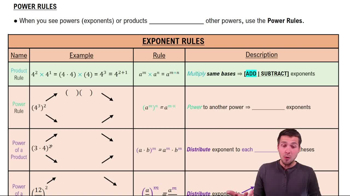Table of contents
- 0. Functions7h 52m
- Introduction to Functions16m
- Piecewise Functions10m
- Properties of Functions9m
- Common Functions1h 8m
- Transformations5m
- Combining Functions27m
- Exponent rules32m
- Exponential Functions28m
- Logarithmic Functions24m
- Properties of Logarithms34m
- Exponential & Logarithmic Equations35m
- Introduction to Trigonometric Functions38m
- Graphs of Trigonometric Functions44m
- Trigonometric Identities47m
- Inverse Trigonometric Functions48m
- 1. Limits and Continuity2h 2m
- 2. Intro to Derivatives1h 33m
- 3. Techniques of Differentiation3h 18m
- 4. Applications of Derivatives2h 38m
- 5. Graphical Applications of Derivatives6h 2m
- 6. Derivatives of Inverse, Exponential, & Logarithmic Functions2h 37m
- 7. Antiderivatives & Indefinite Integrals1h 26m
- 8. Definite Integrals4h 44m
- 9. Graphical Applications of Integrals2h 27m
- 10. Physics Applications of Integrals 2h 22m
1. Limits and Continuity
Finding Limits Algebraically
Problem 5
Textbook Question
Limits and Continuity
In Exercises 5 and 6, find the value that lim (x→0) g(x) must have if the given limit statements hold.
lim ((4―g(x)) / x ) = 1
x→0
 Verified step by step guidance
Verified step by step guidance1
Understand the problem: We need to find the value of lim (x→0) g(x) given that lim ((4 - g(x)) / x) = 1 as x approaches 0.
Recall the definition of a limit: The limit of a function as x approaches a certain value is the value that the function approaches as x gets closer to that value.
Set up the equation based on the given limit statement: Since lim ((4 - g(x)) / x) = 1, we can express this as lim (x→0) (4 - g(x)) / x = 1.
Apply the limit property: As x approaches 0, the expression (4 - g(x)) must approach a value such that when divided by x, the result is 1. This implies that (4 - g(x)) must approach x as x approaches 0.
Solve for g(x): Rearrange the equation 4 - g(x) = x to find g(x). As x approaches 0, g(x) must approach 4 to satisfy the limit condition.
 Verified video answer for a similar problem:
Verified video answer for a similar problem:This video solution was recommended by our tutors as helpful for the problem above
Video duration:
2mPlay a video:
Was this helpful?
Key Concepts
Here are the essential concepts you must grasp in order to answer the question correctly.
Limits
Limits are fundamental in calculus, representing the value that a function approaches as the input approaches a certain point. In this context, we are interested in the limit of the function g(x) as x approaches 0. Understanding limits helps in analyzing the behavior of functions near specific points, which is crucial for solving the given problem.
Recommended video:

One-Sided Limits
Continuity
A function is continuous at a point if the limit of the function as it approaches that point equals the function's value at that point. In this case, continuity is important because it ensures that g(x) behaves predictably as x approaches 0, allowing us to deduce the necessary value of g(0) based on the limit provided.
Recommended video:

Intro to Continuity
L'Hôpital's Rule
L'Hôpital's Rule is a method used to evaluate limits of indeterminate forms, such as 0/0 or ∞/∞. In the given limit expression, if substituting x = 0 leads to an indeterminate form, applying this rule can simplify the limit calculation. This technique is particularly useful when dealing with ratios of functions, as it allows for differentiation to find the limit.
Recommended video:
Guided course

Power Rules

 5:21m
5:21mWatch next
Master Finding Limits by Direct Substitution with a bite sized video explanation from Callie
Start learningRelated Videos
Related Practice







